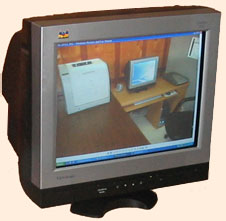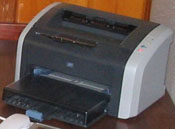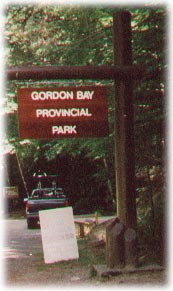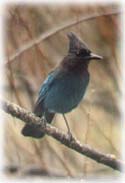

Services
The computers are in the Honeymoon Bay Community Hall, and are open to people of all ages. The hours are 8:30 - 11:30 am, 7 days a week. Also, it is open until 7:00 pm.
The CAP site has 4 computers available for use, as well as 4 printers (2 inkjet, 1 laser and 1 colour laser printer), 2 scanners (including a photo scanner), a photocopier, a fax machine and an internet phone. There is also a coffee club, so coffee is available for a fee.
Fees
Printing:
10 cents per page for black
$1 per page for colour
$2 per page if printing full page colour photos
Community Access Program (CAP)
The Community Access Program (CAP) is a Government of Canada initiative, administered by Industry Canada, that aims to provide Canadians with affordable public access to the Internet and the skills they need to use it effectively. With the combined efforts of the federal, provincial and territorial governments, community groups, social agencies, libraries, schools, volunteer groups and the business community, CAP helps Canadians, wherever they live, take advantage of emerging opportunities in the new global knowledge-based economy. Under CAP, public locations like schools, libraries and community centres act as "on-ramps" to the Information Highway, and provide computer support and training.
CAP is the key component of the Government of Canada's Connecting Canadians initiative, whose goal is to make Canada the most connected nation in the world. CAP started in 1994 in rural communities with populations up to 50,000. Then in December 1999, following a successful pilot program in urban communities, CAP is now being rolled out to larger population centres of over 50,000. By March 31, 2001, Industry Canada wants to establish public Internet access sites in up to 10,000 rural, remote and urban communities across Canada. It's hoped that CAP sites will increasingly join together in networking opportunities enabling them to pool resources and form networks to be able to offer even more to their communities.
Gordon Bay Provincial Park

 Access:
Access:
Gordan Bay Park is located off South Shore Road about 2.5 km west of Honeymoon
Bay Village, on the right side of the road.
Description:
This 49 hectare provincial park of second-growth Douglas fir forest is in one
of Vancouver Island's sunniest valleys. Enjoy the sandy beach and small, placid
Gordon Bay, named for an early settler who lived on the north shore.
The forest was one of the first on the island to be logged, probably because of the relative ease with which the felled trees could be skidded to the lake and floated to the mills. Look for notched stumps. Springboards were sedged into those notches so the fallers could stand on them and work above the dense shrubbery. Today's forest floor is covered with the same kinds of shrubs that made such hard work for the fallers: thimble berry, salal and salmonberry. You can also see vanilla leaf, foamflower and bunchberry which grow closer to the ground.
 As you walk through the forest, look for deer, raccoons and red squirrels.
Bird watchers often see juncos, Steller's jays and chestnut-backed chickadees
as well as mergansers and golden eye ducks. Dolly Varden, rainbow and
cutthroat trout live in the lake, and chum, coho and spring salmon spawn
in the lake and in its tributaries. Steelhead spawn in the Cowichan River.
As you walk through the forest, look for deer, raccoons and red squirrels.
Bird watchers often see juncos, Steller's jays and chestnut-backed chickadees
as well as mergansers and golden eye ducks. Dolly Varden, rainbow and
cutthroat trout live in the lake, and chum, coho and spring salmon spawn
in the lake and in its tributaries. Steelhead spawn in the Cowichan River.
Vehicles:
Licenced drivers can use their properly licensed motorcycles, trail bikes
and mini-bikes on roads and parking lots only. Please keep the operation
of all vehicles to a minimum and watch for children. Speed limit is 10 km
per hour.
Honeymoon Bay Wild Flower Reserve

Access:
The Honeymoon Bay Wild Flower Reserve is located on the South Shore Road
about 2.5 km west of Honeymoon Bay Village, just past Walton Road (which
leads to Gordon Bay Park, and the March Meadows Golf course) on the left
side of the road.
Description:
The Honeymoon Bay Wild Flower Reserve, visited by people from across Canada
each spring, is noted for its unique and spectacular density of the rare
pink fawn lily.
The 6.07 hectare (l5 acres) reserve, owned by Western Forest Industries, is assured the protection in perpetuity of the largest known concentration of pink fawn lilies (Erythronium revolutum) in B.C. It prefers alluvial sites in moderately open woodland with a mild, moist climate. Two dozen species of other wild flowers are also represented there.
On April l5th, l983, the Reserve was officially handed over to the National Second Century Fund of B.C., a nonprofit charitable trust which protects areas and species of ecological interest in the province for the benefit of the people in B.C. About 80 people braved a steady drizzle at the official ceremony.
The National Second Century Fund has offered the 99 year lease of the Reserve to the Ministry of Lands, Parks and Housing at a cost of $l.00, providing the area with ecological reserve status and comes under the management of the ecological reserve unit of the Land Ministry.
Flowers you will find are:
- Western Spring Beauty
- Trillium
- Yellow Arum
- Yellow Woods Violet
- False Lily-of-the-Valley
- Coltsfoot
- Wild Bleeding Heart
- Columbine
- Star Flower
- False Soloman's Seal
- Twisted Stalk
- Star flowered Solomons Seal
- Large Flowered Fairy Bell
- Toothwort
- Meadow Rue
- Vanilla Leaf
- Enchanter's Night Shade
- Baneberry
- Small Flowered Buttercup
- Cow Parsnip
- False Hellebore
- Red Huckleberry
Please remember this is a protected area. Do not pick any flowers or dig bulbs and please take out all litter.
Honeymoon Bay Fire Department

Emergency 9-1-1 Non Emergency 749-6355
PO Box 133
Honeymoon Bay, BC
V0R 1Y0
Fax: 749-6443
 Honeymoon Bay, British Columbia
Honeymoon Bay, British Columbia

